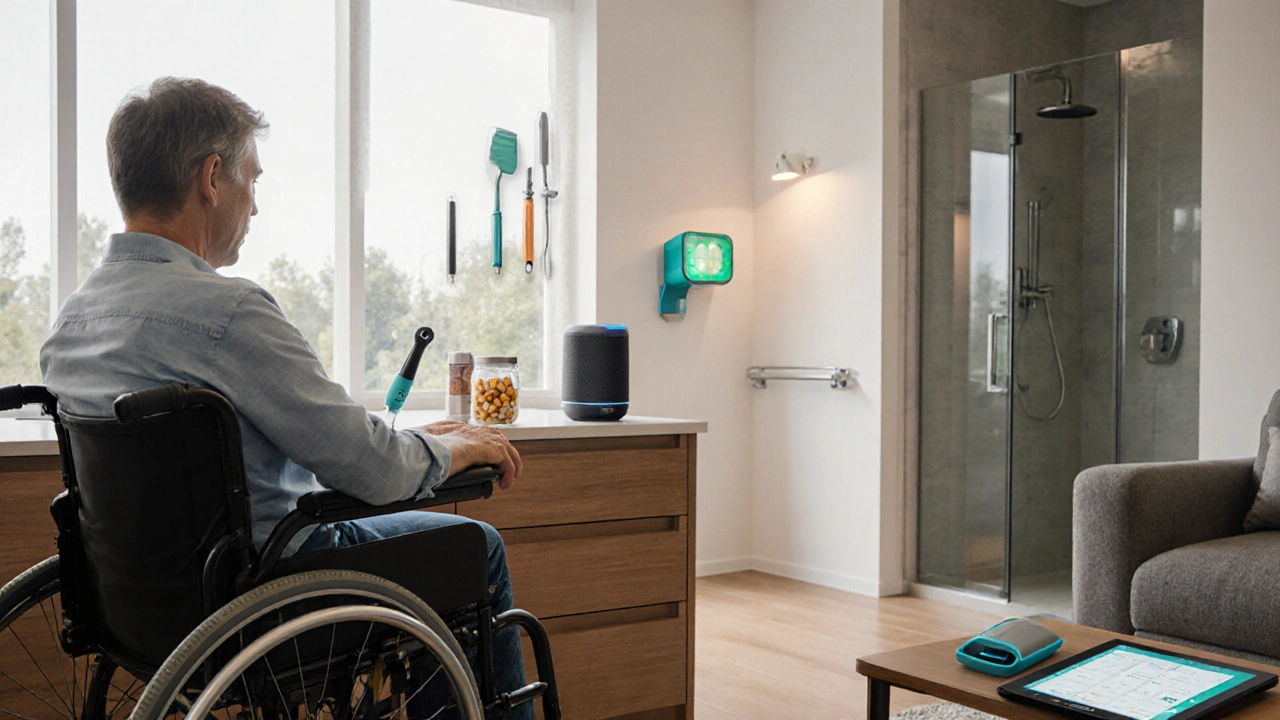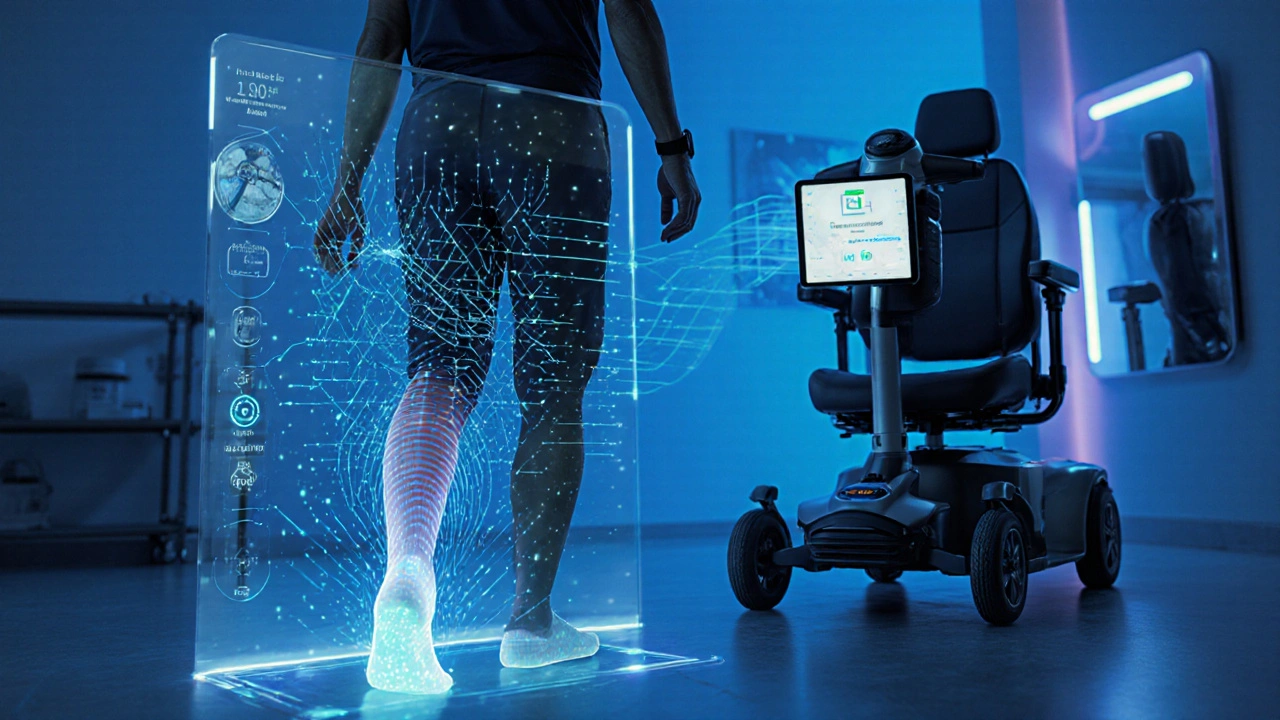RRMS Mobility Aid Selector
Your personalized recommendations will appear here after selecting options and clicking "Find Recommended Mobility Aid".
Comparison Table of Mobility Aids
| Device | Stability Rating | Weight Capacity | Portability | Typical Cost |
|---|---|---|---|---|
| Quad Cane | 250 lb | High | $30-$50 | |
| Four-Point Walker | 300 lb | Medium | $150-$250 | |
| Roll-Through Manual Wheelchair | 350 lb | Low | $400-$800 | |
| Power Scooter | 400 lb | Low | $1,200-$3,500 |
Living with a relapsing‑remitting condition can feel like riding a roller coaster you never signed up for. One day you’re cruising, the next a flare knocks you off balance. The good news is that the right assistive devices can turn those sudden drops into manageable bumps, keeping daily life moving forward.
What Is Relapsing‑Remitting Multiple Sclerosis?
Relapsing‑Remitting Multiple Sclerosis is a form of MS characterized by clear episodes of neurological symptoms (relapses) followed by periods of partial or full recovery (remissions). According to the National MS Society, about 85% of people diagnosed with MS start with the RRMS pattern. During a relapse, inflammation damages myelin, causing vision problems, weakness, or coordination issues. When remission arrives, the body repairs some damage, but often not all.
Why Assistive Devices Matter in RRMS Management
Assistive technology isn’t a luxury; it’s a bridge between the brain’s changing signals and the body’s ability to act. When a relapse hits, even simple tasks-standing up, opening a jar, or remembering appointments-can become overwhelming. Properly chosen devices reduce the physical strain and mental load, letting patients focus on treatment and recovery instead of battling everyday hurdles.
Key Types of Assistive Devices
Below is a quick rundown of the most common categories used by RRMS patients. Each serves a unique purpose and can be combined for a customized support system.
- Mobility Aids - canes, walkers, roll‑through wheelchairs, and power scooters that address gait instability.
- Daily Living Aids - adaptive kitchen utensils, button hooks, and long‑handled reachers to simplify self‑care.
- Cognitive Aids - reminder apps, electronic pill dispensers, and voice‑activated assistants that help with memory lapses.
- Environmental Modifications - grab bars, shower chairs, and non‑slip flooring to prevent falls at home.
- Communication Tools - speech‑generating devices or text‑to‑speech software for patients who experience dysarthria.

Choosing the Right Device: A Step‑by‑Step Guide
- Assess Functional Needs. Work with an Occupational Therapist to identify which daily activities are most affected during a relapse.
- Prioritize Safety. If balance is compromised, start with a mobility aid that offers the highest stability-usually a four‑point walker with a seat.
- Test Fit and Comfort. Devices should be adjustable to the user’s height and weight. Improper fit can cause new strain injuries.
- Consider Long‑Term Progression. Choose devices that can be upgraded. For example, a lightweight manual wheelchair can later be converted to a power‑assist model.
- Budget and Reimbursement. Verify coverage with the Neurologist’s insurance plan or local disability services. Many organizations offer grants for home modifications.
Integrating Devices Into a Comprehensive Care Plan
An assistive device works best when it’s part of a broader treatment strategy that includes medication, Physical Therapy, and lifestyle adjustments. Here’s how to align them:
- Medication Timing. Use a medication reminder app on the same device that controls your smart home lights, ensuring you never miss a dose even during fatigue.
- Exercise Routines. Physical therapists can prescribe a walker‑compatible strength program that keeps leg muscles active without risking falls.
- Fatigue Management. Schedule rest periods around device‑intensive activities. Power scooters, for instance, conserve energy for social engagements later in the day.
Real‑World Examples
Emily, 34, diagnosed with RRMS in 2022, found that a simple cane was insufficient during a severe relapse that left her with a pronounced tremor. After a consultation with her occupational therapist, she switched to a four‑point walker equipped with a built‑in seat. The added stability reduced her fall risk by 70% and gave her the confidence to return to part‑time work within three months.
James, 58, struggled with memory lapses that made pill management chaotic. He adopted an electronic pill dispenser synced with a voice‑activated smart speaker. The device not only buzzed when it was time to take medication but also read aloud the drug name, cutting his missed‑dose incidents from five per month to zero.
Common Pitfalls and How to Avoid Them
- Over‑reliance on a single device. Relying solely on a wheelchair can lead to deconditioning of the legs. Combine mobility aids with regular stretching.
- Ignoring Home Layout. A device may be perfect, but if thresholds or door widths are too narrow, it becomes useless. Conduct a home safety audit before purchase.
- Skipping Professional Training. Improper use of a power scooter can cause accidents. Schedule a hands‑on training session with a certified therapist.

Future Trends: Smart Assistive Technology
Wearable sensors that detect gait changes are entering the market, alerting patients and clinicians before a fall occurs. Integration with electronic health records means real‑time data on mobility can inform medication adjustments, creating a feedback loop that tailors treatment to each relapse pattern.
Quick Checklist for RRMS Patients Considering Assistive Devices
- Consult an occupational therapist for a functional assessment.
- Identify the most affected daily tasks.
- Choose a device that offers adjustability and upgrade potential.
- Verify insurance coverage or look for nonprofit grants.
- Plan for integration with medication schedules and therapy routines.
- Schedule regular re‑evaluations every six months.
| Device | Stability Rating (1‑5) | Weight Capacity (lb) | Portability | Typical Cost (USD) |
|---|---|---|---|---|
| Quad Cane | 2 | 250 | High (foldable) | 30‑50 |
| Four‑Point Walker | 4 | 300 | Medium (disassembles) | 150‑250 |
| Roll‑Through Manual Wheelchair | 3 | 350 | Low (heavy) | 400‑800 |
| Power Scooter | 5 | 400 | Low (requires charging) | 1,200‑3,500 |
Next Steps: Getting Started Today
1. Schedule a professional assessment. Reach out to your local rehab center and request an occupational therapist referral.
2. Make a short list of needed functions. Write down three tasks that become hardest during a relapse.
3. Research coverage. Call your insurer’s assistive‑device department and ask about the “durable medical equipment” (DME) policy.
4. Trial before you buy. Many suppliers offer a 30‑day return window; use it to ensure the device fits your lifestyle.
Frequently Asked Questions
Can I use a mobility aid only during relapses?
Yes. Many patients opt for a collapsible walker that can be stored when not needed. The key is to keep it accessible so you can deploy it quickly if a flare starts.
Will my insurance cover smart assistive devices?
Coverage varies. Traditional devices like canes and wheelchairs are usually covered under DME. For newer tech-wearable sensors or voice‑controlled pill dispensers-check if they’re classified as “medical necessity.” A physician’s prescription can improve approval odds.
How often should I re‑evaluate my assistive devices?
Every six months or after any major relapse. Changing symptoms may require a different level of support, so schedule a follow‑up with your therapist.
Are there grants for home modifications?
Many national MS societies and local disability agencies offer grant programs for ramps, grab bars, and bathroom upgrades. Research the NMSS “Home Accessibility” grant or your state’s assistive‑technology fund.
What’s the best way to combine medication reminders with a mobility aid?
Pair a medication reminder app on a smartphone with a wearable smartwatch that vibrates. If you use a power scooter, many models have built‑in USB ports for charging the watch, keeping both tools synced.


Anyone who thinks assistive devices are a crutch is simply pandering to a comfort‑obsessed culture.